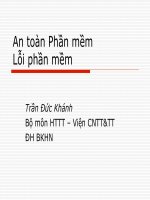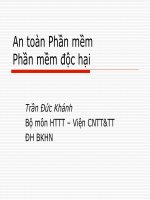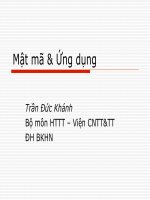slike bài giảng web thế hệ mới - trương thị diệu linh 11 hyper text transfer protocol (http
Bạn đang xem bản rút gọn của tài liệu. Xem và tải ngay bản đầy đủ của tài liệu tại đây (61.68 KB, 16 trang )
Hyper Text Transfer Protocol (HTTP)
Objective: Understand HTTP (the protocol that makes the Internet possible)
Accessing Resources over the Web
•
<protocol>://<server>/<path>
Defines the address
(Uniform Resource
Locator)
Communication
Protocol between the
client and the server
Hypertext Transport Protocol (HTTP) characteristics
•
Request-response mechanism:
–
Transaction is initiated by a client sending a request to server
–
Server generates a response
•
Resource Identification
–
Each HTTP request includes a URI (Uniform Resource Identifier)
•
Statelessness
–
The server does not maintain any information about the transaction
•
Meta data support
–
Metadata about information can be exchanged in the messages
HTTP Request Format
GET /index.html HTTP/1.0Request Line
Host: www.content-networking.com
Date: BBBBBBBBBBBB
User-Agent: Mozilla/5.0 (en) (WINNT; U)
Accept-Language: en-us
Header Lines
Carriage
Return/Line
Feed
Specifies request
method
Specifies resource via URI
& meta data
Message Body
Content-length:
(Message Payload)
Request Methods
•
GET
–
whatever information is identified by the Reuest-URI
–
Can Get static content and data produced by a program
•
POST
–
Submit information to Web Server
–
Eg: posting to blog, submission of user form…
–
Information is included in message body
–
The actual function depends on request URI
Example
POST/phonebook.cgi.HTTP/1.0
Date:
User-Agent:
Accept Language: en-us
Content Length: 14
98490 55266
Looks up phone book for the number
Could have been also achieved by Get
But in that case number would have been in
the Resource URL
Which would have been stored in the log
Request Methods…contd (ii)
•
HEAD
–
Servers response does not include message body
–
Useful for getting resource metadata without transferring the resource
–
Also useful for debugging , checking for validity, accessibility and modification
•
PUT
–
Requests a server store the enclosed data under the supplied Request URL.
–
Creates the resource if it does not create
–
Not useful for web publishing (FTP is preferred for security purposes)
•
DELETE
–
Removes the Web object
–
Needs to be carefully used for security reasons
Request Methods…contd (iii)
•
TRACE method
–
Invokes a remote appliction layer feedback of the request message
–
Useful for testing what is being received at the server
–
Also possible to forward to intermediaries for debugging purposes
•
OPTIONS
–
Requests information about communication options available to server
HTTP Response Format
HTTP/1.0 200 OK Status line
Date: BBBBBBBBBBBB
Server: Apache/1.3.12 (Unix)
Last-Modified: (date)
Content Type: text/html
Header Lines
Carriage
Return/Line
Feed
Status line with result
code and phrase
Specifies server &
resource meta data
Message Body
Content-length:
(Message Payload)
Result Code and Phrase
•
1xx: Informational – Not Done Yet
•
2xx: Success – You win
•
3xx:Redirection-You lose but try again
•
4xx:Client Error – You lose, your fault
•
5xx:Server Error – You lose, my bad
200 OK
204 No Content
300 Mutiple Choices
301 Moved Permanently
302 Moved Temporarily
304 Not Modified
400 Bad Request
401 Unauthorized
404 Not Found
500 Internal Server Error
Improvements in HTTP/1.1
•
Persistent connections
–
Keeps the connection open after the server response
–
Connection can be closed by either client or server
•
Request Pipelining
–
Allows a client to send several requests without waiting for a response
–
Server responds in the same order
•
Chunked Encoding
–
Allows sender to break a message into arbitrary sized chunks
–
Useful for dynamically created response messages
Cookies
•
HTTP is stateless protocol
•
Cookies manage state maintenance by shifting the burden to
client
•
Cookies are transmitted in clear text (security issue)
Client
Server
Usual HTTP Request
Usual HTTP Response, including header
line Set-cookie: <cookie>
1
st
client
request
Usual HTTP Request, including header
line Set-cookie: <cookie>
Usual HTTP Response
2nd client
request
Client does not
interpret the
cookie string
Server is
presented with
the previously
returned state
information
User Authentication
•
Users browser information remembers credentials and includes them in
headers for subsequent requests
•
Browser typically deletes stored authentication credentials once browser
is closed
•
HTTP allows various authentication mechanisms
Client
Server
Usual HTTP Request
HTTP Response with code 401, including
header line www-authenticate: <string1>
Same HTTP Request, including header
line Authorization: <string2>
Usual HTTP Response
1
st
client
request
User inputs
credentials
Usual HTTP Request, including header
line Authorization: <string2>
Usual HTTP Response
2ndclient
request
SSL: Secure Web Communications
•
SSL protocol is application independent
•
Operates between application layer and transport layer
•
Application protocols such as HTTP sit on top of it and TCP/IP
beneath it
•
SSL provides:
How SSL Works
•
The Public Key is a random number generated in pair (the other part of
the pair is the private key known only to the server)
•
Data encrypted by the public key can be decrypted only by using the
private key
Client
Server
HTTPS Request
SSL Certificate with the Public Key of the
Server
Sends Session Key encrypted with the
Server Public Key
Response/Request encrypted with
session key
Generates
a random
number or
session key
which can
be
encrypted
using the
server
public key
Decrypted
using the
Server
Private Key
Ensuring SSL version compatibility
•
There are different versions of SSL depending on the
encryption algorithm used.
•
The browser sends the versions it supports
•
The server sends the certificate. The certificate includes:
–
The identity of the organization to which the web server belongs
–
The certificate’s expiration date
–
The public key
–
The identity of the organization that issued the certificate, known as a
certification authority (CA)
•
Browsers store and recognize certificates issued by a number
of well-known CAs.
What it does and what it does not
What It Does What it Does Not
Data encryption
Server authentication
Message integrity
Optional client authentication
SSL does not protect the data stored on
the disk.
Information getting stolen through pages
cached on the browser
Stealing confidential information from the
browser memory. Since in SSL data is
encrypted only during transmission on
the network, it is in clear text in the
browser memory









